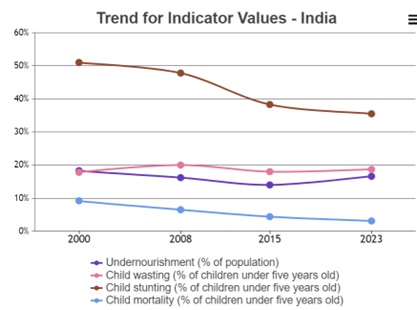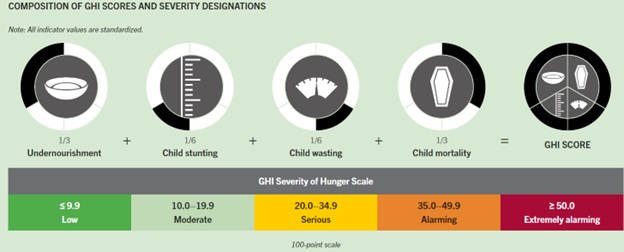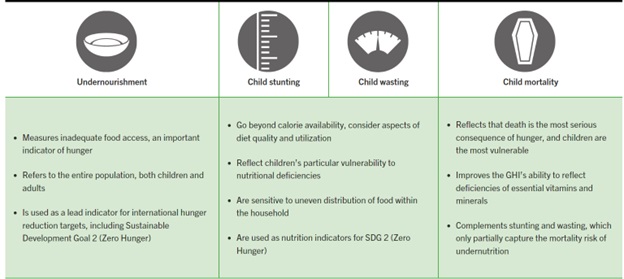Global Hunger Index Highlights India’s Malnutrition Challenge
Relevance
- GS Paper 2 Issues relating to Poverty and Hunger.
- Tags: #GlobalHungerIndex #Malnutrition #MintEditorial #UPSCMains2024.
Why in the news?
The recent Global Hunger Index (GHI) report has ignited debates in India. While there are concerns over the ranking, the focus should shift to addressing issues like infant mortality rates and child nutrition adequacy.
The Global Hunger Index (GHI)
- The GHI is a report co-published by Concern Worldwide and Welt Hunger Hilfe, established non-governmental organizations from Ireland and Germany, respectively.
- It has a transparent, peer-reviewed methodology and serves as a tool to assess and address global hunger issues.
Understanding the Global Hunger Index (GHI)
- The Global Hunger Index (GHI) measures hunger and malnutrition worldwide.
- GHI scores aren’t always comparable due to ongoing data revisions by the United Nations.
- However, the 2023 scores are designed for comparisons with 2000, 2008, and 2015.
- The total score ranges from 0 to 100.
| GHI Score Range | Classification |
| Above 50 | Extremely Alarming |
| 35 to 49 | Alarming |
| 20 to 34 | Serious |
| Below 20 | Moderate or Low |
- India’s GHI score is 28.7, showing a slight 5 point improvement since 2015.
- India falls in the “alarming” category, along with 43 other countries.
- Its global rank is 111 out of 125 countries, and it ranks lower than its South Asian neighbors.
Controversy Surrounding GHI Ranking
- The Global Hunger Index (GHI) has sparked controversy, with the Ministry of Women and Child Development (MWCD) objecting to its use as a measure of hunger.
- They argue that GHI’s low ranking for India may suggest widespread starvation and food security crises, which they believe isn’t accurate.
- Historical data, such as the National Sample Survey (NSS) from the late 1990s, has shown that food availability in India has been adequate.
Measuring Hunger and Malnutrition
- Around 30 years ago, India’s National Sample Survey (NSS) asked a simple question: Did you eat a single meal or more during the day?
- About 95% answered affirmatively.
- However, the Global Hunger Index (GHI) goes beyond calories.
- It assesses both hunger and malnutrition, including a lack of essential nutrients.
- GHI comprises four components, with equal weight given to undernourishment and child mortality, while the remaining third is divided between child stunting and wasting.
- Data on child wasting (18.7%) and stunting (35.5%) come from India’s fifth National Family Health Survey (2019-2021).
- The GHI offers a more comprehensive view of nutritional challenges.
Data Inconsistency: India’s Nutrition Challenges
- India’s data on child nutrition paints a concerning picture, ranking among the worst 15 countries.
- However, the Ministry of Women and Child Development’s (MWCD) Poshan (nutrition) tracker shows a lower stunting rate of 7%.
- The contradiction in government sources suggests a need for data clarification.
- Critics argue that since three of the four GHI components focus on child nutrition or hunger, it might not fully represent the entire population.
- In a youthful country like India, children’s well-being holds significant importance, and understanding these discrepancies is essential for effective policymaking.
Focusing on Solutions for Hunger and Malnutrition
- Rather than reacting negatively to India’s low global ranking in the Global Hunger Index (GHI), it’s essential to understand the underlying issues and work toward improvement.
- India’s hunger and nutrition situation is far from ideal, as evident from the extensive free food grain distribution to 810 million people over the last four years, a move driven by concerns over food security.
- Local experience indicates that there is potential for improvement on a micro level.
- To measure societal well-being, the infant mortality rate (IMR) at age 1, rather than at birth, is a crucial indicator.
- It’s vital to convert critique into effective actions for better nutrition and well-being.
Importance of Tracking IMR at Age 1
- Tracking the Infant Mortality Rate (IMR) at age 1 involves following a sample of 1,000 births until each baby reaches their first birthday.
- This differs from the common IMR at birth, which only counts live child births per 1,000.
- Properly monitoring IMR-1 is crucial as it is closely linked to various development indicators.
- Unfortunately, India doesn’t adequately track IMR-1.
- Prioritizing the reduction of IMR-1, similar to initiatives like Project Tiger, should be pursued with a mission-driven approach to improve child well-being.
Critical Infant Mortality Issues in India
- India’s reported Infant Mortality Rate at age 1 (IMR-1) stands at approximately 33, with significant variations across states.
- In comparison, developed nations track IMR until age 5. Shockingly, in 2018, an estimated 882,000 Indian children under five lost their lives, the highest globally.
- Recent incidents, like the tragic deaths of over a dozen babies in a Maharashtra hospital within 24 hours, highlight systemic problems.
- Root causes include inadequate primary, ante, and post-natal care, and a severe shortage of medical and para-medical staff.
- These challenges persist, contributing to both infant mortality and widespread undernourishment and nutritional deficiencies among surviving infants.
While the Global Hunger Index (GHI) rank sparks concerns and conspiracy claims, rather than getting caught up in disputes over rankings, it’s essential to shift our attention towards meaningful actions. Concentrating on reducing Infant Mortality Rate at age 1 (IMR-1), along with tackling issues like child stunting and wasting, is vital for India’s large child population.
|
Components of Global Hunger Index (GHI) Undernourishment
Child Stunting
Child Wasting
Child Mortality
|
Source: Livemint, globalhungerindex.org
Mains Question
Discuss the methodology and significance of the Global Hunger Index (GHI) in assessing the state of hunger and malnutrition. Why is India’s rank in the GHI a subject of debate?






